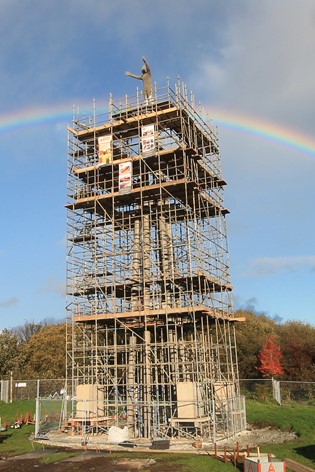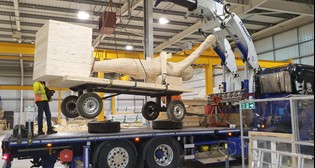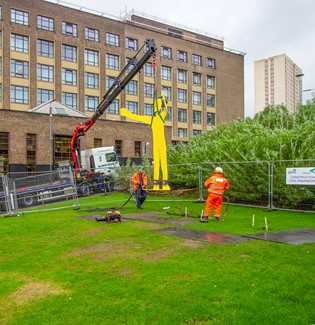Build and Materials
A 75% lower carbon impact due to its sustainable approach to construction and a catalyst for global change.
"We all need to address this new global agenda so our young can embrace a future of hope. It is very simple, why would anyone want to poison their future?"
Steuart Padwick, Artist and Designer
This gift to Glasgow and South Lanarkshire is a showcase of how our industry can respond to build a better, more sustainable future.
Working with artist and designer Steuart Padwick, principle build partners Ramboll, Aggregate Industries, Urban Union, Keltbray and over 50 other partners and collaborators, have completed the COP26 legacy Hope Sculpture with a 75% lower carbon impact due to its sustainable approach to construction.
Where possible all materials designed and selected for the project have either been reclaimed, recycled, or are sustainable. The construction is being approached in the lowest carbon way, mostly using locally sourced materials and suppliers.
The Hope Sculpture, located at the Cuningar Loop park is constructed from 100% cement free concrete and includes recycled gas pipes for the piling. The bespoke cement free product has been developed by the Aggregate Industries’ technical experts in close partnership with the project team. This high strength product is part of their ECOPact Max green concrete range and reduces the carbon footprint by more than 70% compared to a standard concrete mix. Also, incorporated in the concrete mix is recycled steel rebar. The cement free concrete mix design utilises a local Duntilland Dolerite aggregate and sand and the cast child (made out of ECOPact Max+), includes 20% recycled glass aggregate from Dryden Aqua, who recycle about a quarter of Scotland’s glass. The addition of glass to this structural concrete is made possible due to the mix being cement free.
Locally quarried Caithness stone will form the landscaping and benches. Soft, low energy lighting is respectful of the environment and of local wildlife and uses fittings designed and manufactured in Scotland for the Circular Economy.
The industry has long been championing the use of modern methods of construction to transform how projects are delivered. This build is a showcase for offsite manufacturing delivering greater efficiencies, higher quality, safer solutions and lower greenhouse gas emissions than traditional construction methods.
The Beacon of Hope located at Network Rail’s Glasgow Central Station is being constructed in Sustainably Managed FSC Scottish Grown Sitka Spruce. It celebrates the growing Cross Laminate Timber (CLT) construction industry that Scotland is developing.
The Hope Triptych, located at Strathclyde University’s Rottenrow Gardens is constructed from reclaimed folded sheet steel and its foundation is be made from 100% cement free concrete.
"The carbon savings on this project are huge and it demonstrates what can be achieved when you approach projects with a lean construction mindset, you are sensible with materials and can hone the design early on. Our industry already has at its disposal many of the technologies and approaches to achieve substantial reductions, the key to unlocking those, are ambition and collaboration, something all the 50 partners and collaborators for this project have had"
Alan Dowdall, Buildings Director
Ramboll"Our organisation is transforming itself, globally and locally, to become the leader in innovative and sustainable building solutions. That’s why we are proud to be supporting such an iconic project with a bespoke cement free product developed by the Aggregate Industries’ technical experts in close partnership with the project team. This high strength product is part of ECOPact Max green concrete range, reducing the carbon footprint by more than 70% compared to a standard concrete mix. If we can achieve that on a singular project, just imagine what we can do if we use these sustainable solutions at a large scale, redesigning neighbourhoods and cities."
Dragan Maksimovic, CEO
Aggregate Industries"Keltbray is honoured to be a part of The Hope Sculpture project. The sculpture is a powerful symbol and it means a lot to us to be able to help deliver such an important beacon of hope. Our values are very much aligned with the project, as sustainability and wellbeing are embedded in everything we do as a business. We have very much enjoyed collaborating with the other businesses involved to bring this meaningful sculpture to the people of Glasgow."








